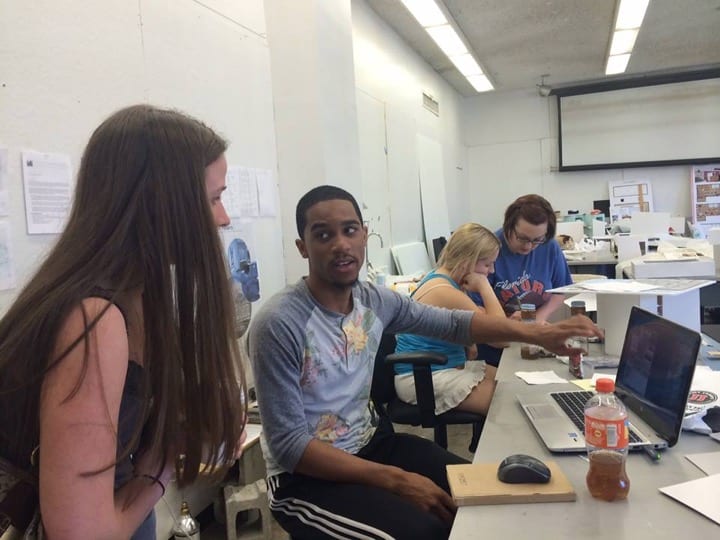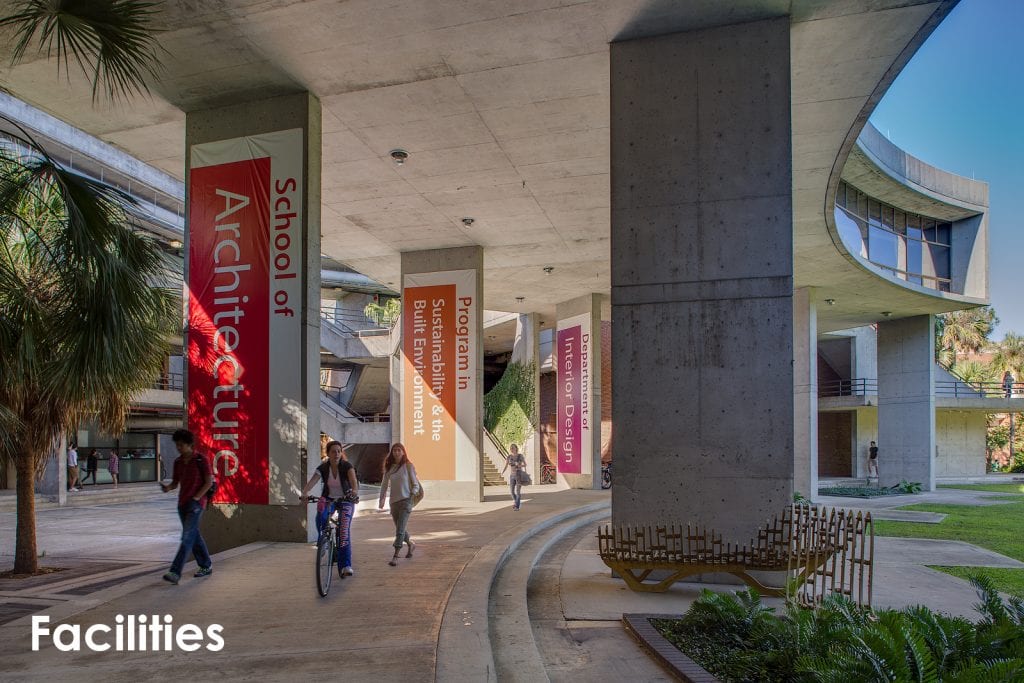The Department of Interior Design at the University of Florida is an internationally recognized program committed to evidence-based design that emphasizes the role of human centered research to guide the design process.

This process centers around the human occupants and how design can optimize the interior to meet human needs through healthy, safe, functional, sustainable, and culturally sensitive designs. Our interdisciplinary foundational design studios offer the knowledge and hands-on skills necessary to excel in many design fields. The studio environment, mentored by professional and NCIDQ certified faculty, allows for individual and team project-based learning that combines design thinking, intensive research, design development, creativity and technical skills which sets up our graduates to become leaders in the field. Our Program has been accredited by the Council for Interior Design Accreditation (CIDA, formerly FIDER) since 1974 and has continuosly placed graduates in top positions in the field… and have the data to show it!
The Mission of the University of Florida
The University of Florida is a comprehensive learning institution built on a land-grant foundation. We are The Gator Nation, a diverse community dedicated to excellence in education and research and shaping a better future for Florida, the nation and the world.
Our mission is to enable our students to lead and influence the next generation and beyond for economic, cultural and societal benefit.
The university welcomes the full exploration of its intellectual boundaries and supports its faculty and students in the creation of new knowledge and the pursuit of new ideas.
- Teaching is a fundamental purpose of this university at both the undergraduate and graduate levels.
- Research and scholarship are integral to the educational process and to the expansion of our understanding of the natural world, the intellect and the senses.
- Service reflects the university’s obligation to share the benefits of its research and knowledge for the public good. The university serves the nation’s and the state’s critical needs by contributing to a well-qualified and broadly diverse citizenry, leadership and workforce.
The University of Florida must create the broadly diverse environment necessary to foster multi-cultural skills and perspectives in its teaching and research for its students to contribute and succeed in the world of the 21st century.
These three interlocking elements — teaching, research and scholarship, and service — span all the university’s academic disciplines and represent the university’s commitment to lead and serve the state of Florida, the nation and the world by pursuing and disseminating new knowledge while building upon the experiences of the past. The university aspires to advance by strengthening the human condition and improving the quality of life.
View details »
UF’s Strategic Development Plan »
The Mission of the College of Design, Construction & Planning
‘DCP pursues its vision and mission with guidance provided by its Strategic Plan Goals and Strategies, a collaboratively developed blueprint addressing all aspect of college organization and activities. It covers academic and professional program structure and operation, support for research, community engagement, faculty development, facilities (including instructional technology), student recruitment and enrollment, internationalization and alumni and development efforts. The initial Strategic Plan adopted by the faculty in 2007 was recast and forwarded to the DCP Faculty Council for review this year in response to new DCP initiatives and to incorporate updated performance metrics.’
View details »
Our Mission in Interior Design
The Department of Interior Design strives to position students well to enter the profession in the State of Florida or with our expanding alumni base that includes Atlanta, Austin, New York, Chicago, and Seattle. Feedback from graduating seniors shows that the UF learning experience in the program was excellent. Students benefit from a close-knit studio culture. At UF, students benefit from our outstanding teaching faculty.
During studios and in internships, students have unique opportunities to engage with interior designers, architects, and industry specialists who help guide professional growth. Students love hands on design projects using the UF living laboratory. They also develop strong skills doing community-based design, competitions, and other cutting-edge projects from many firms who partner with our program. In essence, interior design at UF is creative, team-based, and exciting.
In 1925, the newly established School of Architecture at the University of Florida was established within the College of Engineering, offered a four-year program leading to a bachelor of science in architecture. Four years later, the program became an independent unit known as the School of Architecture and Allied Arts in 1929. After a period of development and maturation, the School of Architecture and Allied Arts was first accredited by NAAB in 1948, thus helping elevate the school to college status in 1948. Notably, a four-year program in Interior Design also was formed in the College of Architecture and Allied Arts in 1948 with a curriculum culminating in a Bachelor of Arts in Interior Design. In 1952, the interior design program changed academic homes to the Department of Architecture where a four-year interdisciplinary curriculum in Interior Design leading to a Bachelor of Design with a major in Interior Design was approved. The Department of Interior Design received its first accreditation from the Foundation of Interior Design Education and Research in 1974 and has maintained continuous accreditation for the past 43 years.

In 1975, the College of Architecture and Fine Arts divided into two separate entities: College of Architecture and College of Fine Arts. The Department of Architecture gained college status in 1975 and seven years later the interior design program gained department status in 1982 with support from the college faculty, university senate and university president. The Department of Interior Design became one of five academic units in the College of Architecture, including architecture, building construction, landscape architecture, and urban and regional planning. In 1985, the University of Florida was admitted into the Association of American Universities (AAU), confirming the university’s stature as a top-tier research university.
The Department of Interior Design increased its degree offerings in 1999 to include a Master of Interior Design (MID). This action brought the department’s instructional and scholarly activities in line with those of the university and college. This milestone extended the department’s research and teaching mission. In 2000, the College of Architecture was renamed to the College of Design, Construction and Planning. DCP consisted of two schools: School of Architecture and M.E. Rinker, Sr. School of Building Construction, and three departments: Department of Interior Design, Department of Landscape Architecture, and Department Urban and Regional Planning.
Concurrently the DCP doctoral program expanded in 2000 to include all academic units in the college. Another development for the department of interior design involved a new combined degree offering in 2003 that allows advanced undergraduate students to take up to 12 credits of graduate coursework that can be applied to their undergraduate degree and the MID. The 4+1 or combined degree students can then complete the MID in one full year following undergraduate graduation. Similar 4+1 programs were established across the university. In the past ten years, the MID program expanded and then maintained a steady enrollment of about 20 students. During the past decade, the college doctoral program has doubled in enrollment, topping 100 students. During the past 13 years under the current department leadership, doctoral enrollment within the department of interior design grew from one to eleven students. Likewise, the department faculty approved to supervise Ph.D. students (i.e., doctoral research faculty) increased to five (Bosch, Cunningham, Park, Portillo and Valipoor).
In summary, the department has evolved from having a sole focus on providing outstanding undergraduate education to a program that not only offers an excellent undergraduate program but also invests in graduate education. The undergraduate program receives benefits from this structure. Doctoral and MID students often engage closely with undergraduates in roles that support teaching and learning. For example, many MIDs have more life experience, come from different parts of the world, and have undergraduate degrees in fields such as architecture, graphic design, education, or the health sciences. Integrating MID students onto studio teams with undergraduates creates a broader and deeper worldview from which to design.









